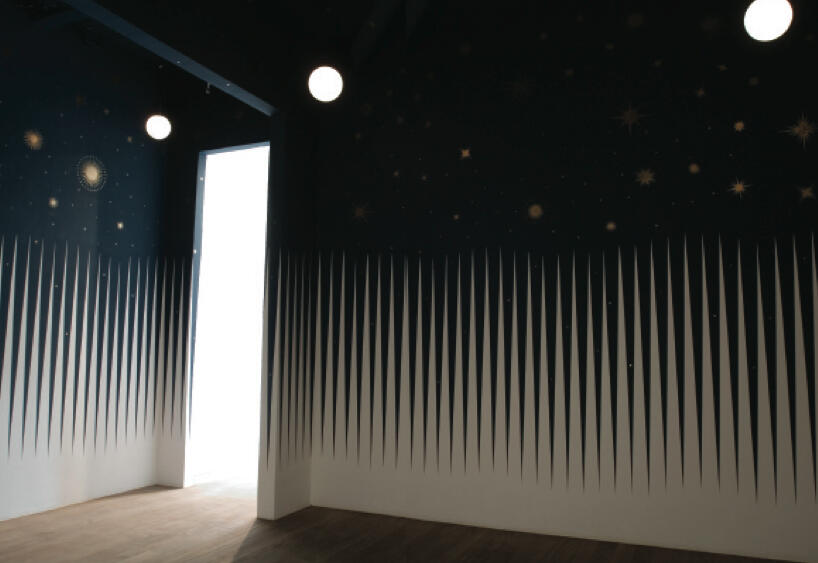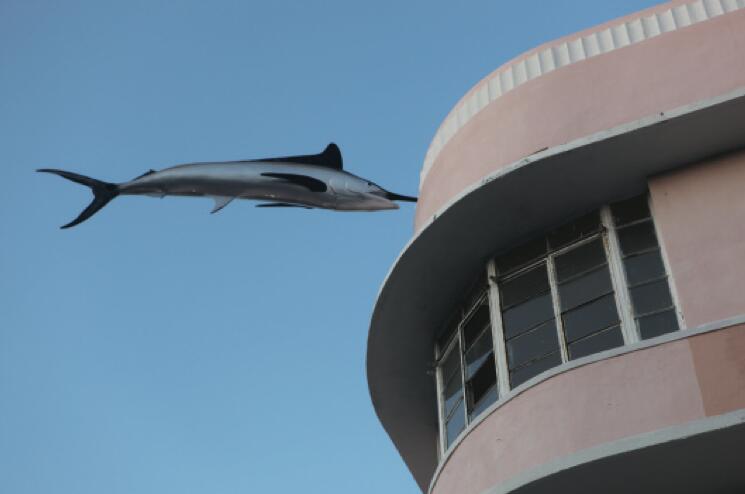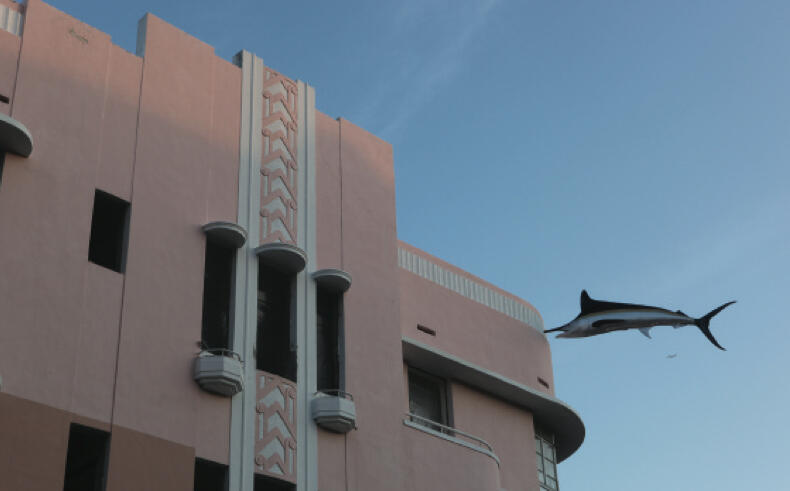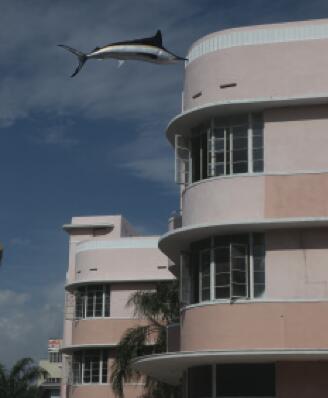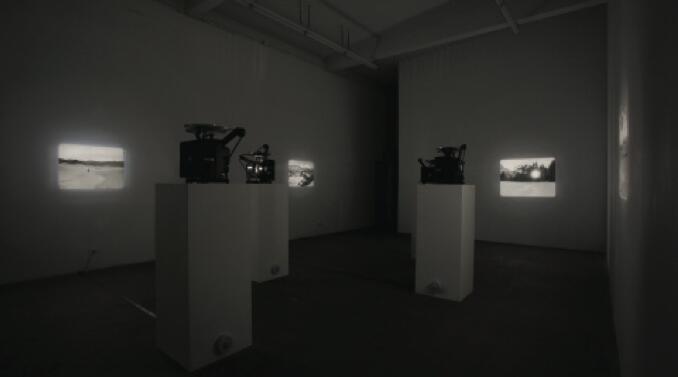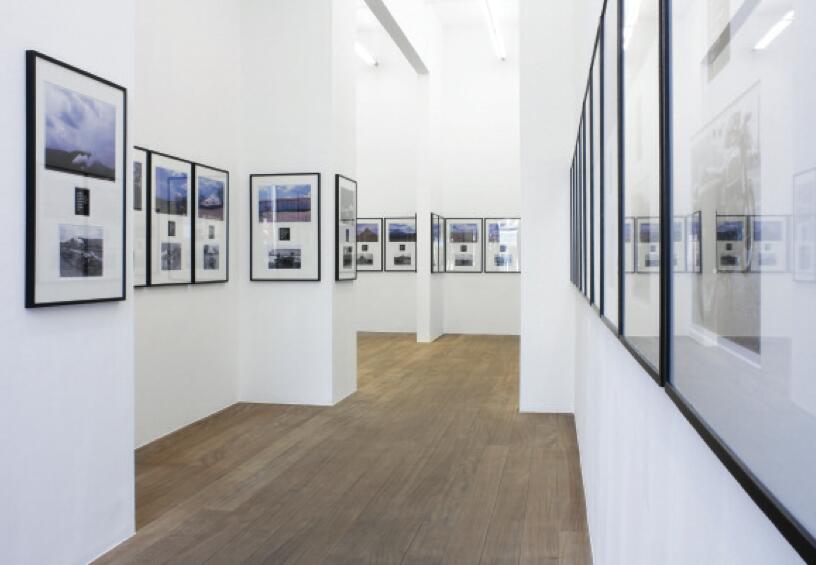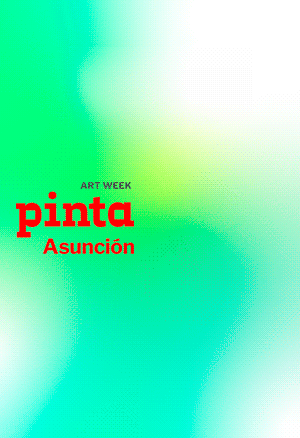Gonzalo Lebrija
OR THE LIGHTNESS OF AVENTURE
“ The concentrated instant”: that synthesis of time and vital intensity that Gonzalo Lebrija began to pursue during his apprenticeship as assistant director of photography in the field of cinematography, when he discovered that the sequential logic of a long narrative could be replaced by the climax of scenes capable of containing everything, explains the iconic hypnotic alibi in his works, capable of transforming the attempt at the impossible into a game.
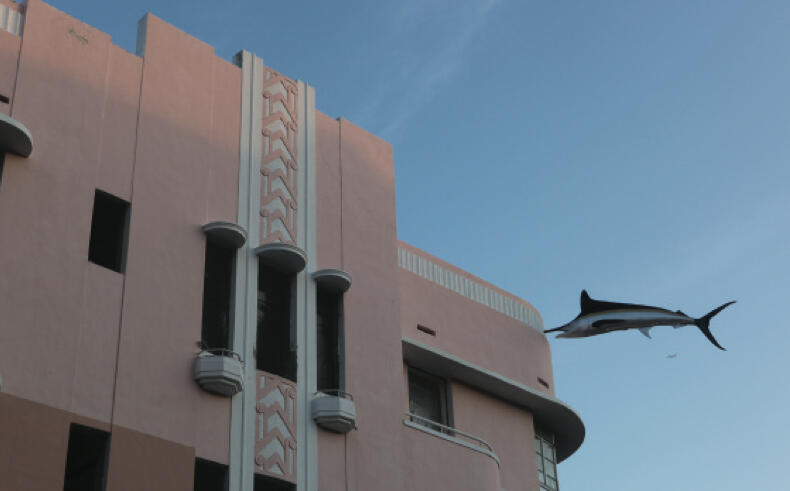
It is present, for instance, in Matapalomas: a hunting rifle fixed with tape to a wall beside a window in his attic in Guadalajara, with the failed purpose from the very outset of frightening away pigeons. Or in the surrealist beauty of the red surface of a coveted modern machine a Ferrari which he placed within the Neoclassical architecture of the Cabañas Museum in Guadalajara and transformed into a mirror of the murals in which Orozco painted Prometheus, in a fallacious attempt to project the metaphor of the theft of fire onto his own attempt.
At a time when the great narratives have been disarticulated and, as Raymond Chandler wrote in The Simple Art of Murder, the only possible adventure is art, Lebrija shows the legitimate cunning of a new Ulysses who has gone adrift, hunting concentrated instants, with a rare combination of mental distance and physical proximity with regard to the world he explores, without realizing that he has left behind him not only indelible traces of episodes that occurred as precise responses to a time-space, but also a journey that reveals part of the post-modern artist’s enigma. The thread of his wanderings is an essay on adventure at a time when epic poetry no longer exists. Confronting the absence of great purposes, instead of repeating the nihilist gesture or the exhausted effort of the transgressor, he invents a ludic attitude. Adventure as its etymological origin, advenire, indicates implies preparing for “that which is to come”. Lebrija embarks on adventure not on the basis of the modern wish that as Brian McHale specifies, sought a possible epistemology of the world, but on the basis of an ontological exploration connected to the being, which defines the strategies of art and life and resorts to the most ancestral and amusing of these: travel.
From the initial Autopaisajes that captured the surrounding geography on the metal surface of the cars, to the series The Distance Between You and Me, in which the camera records the race he sets out on until he dissolves into the horizon of distant places, the journey takes place with the lightness of a game,
without however losing its initiatic power, and it presumably represents a vanishing point leading somewhere else. Lebrija avoids tragedy, even if the journey ends up in dissolution, as is the case of the racing black car in Entre la vida y la muerte (Breve historia del tiempo), which he plunges into a lake in a scene shot at 150 frames per second, in such a way that the slowness (the antipodes of time gliding into the dissolution of all things) endows the fall with the suspended quality of a soft immersion, and the object disappears in the midst of beautiful waves.
There is no tragedy here, either, because the viewer assumes the nature of his fictional games even in the case of exhausting journeys, such as the one represented in R75/5 Toaster, in which his own body is involved. The artist traveled under the sun’s ray at a temperature of 40 degrees from California to the Carrillo Gil Museum in Mexico City, riding a motorbike that somehow resembles him (it was a 1972 model, the same year of his birth), but the limit of the endeavor is not that of the Viennese Actionists; it is not even that of Bruce Nauman or Chris Burden’s searches; it is the limit of explorations open to a ludic sense of “fatum” (fate, destiny, weirdness) which hurls him, like Baudelaire in Le Voyage, to the depths of the unknown to find that which is new, but in such a way that instead of falling into the abyss, he floats.
The fall of this Post-modern Icarus has lightness as a safety net, as in Catch my Fall, where the flight will reach the bedroom ceiling wearing a pajama adorned with stars and a bed will stop the fall. “It was,” he says, “like wrapping myself up in the universe to jump into the void”. Adventure ends in fictional images where apparently contradictory planes converge in a strange way and without friction, drawing possible destinations for himself or for others. The mask (phersus, origin of the term ‘person’) of a personage, which contributed an identity in ancient times, permits the invention of destinies (and destinations) depending on randomness and saved by humor.
To pervade the less ludic spaces with this attitude is a way of eroding the narratives of power that continue to function in the midst of the expansion of capitalism and of multiple hegemonies. In Éxodo (Competencia de aviones), he made the members of a law firm play with paper airplanes, and in Asterion, a businessman riding a bull ends up watching the contents of his briefcase fly in that atmosphere without gravity and in slow motion (once again, lightness and slowness dissolve the tragic element). This same strategy of play as a way out animated Three White Horses, produced in response to the creative pressure he underwent while attending an artist residency in Braziers Park, England. The random image of some white horses on a match box inspired him to transport them from the image to the field in front of the house, where they grazed on bales of hay piled up by José Miguel Suro and forming the word ‘bureaucracy’.
In the adventure of his works, open to randomness and vulnerability, he retraces the narratives of modernity, which have become exhausted. In Dirty Wish (2007), a blot of black ink in the pristine sky against which the blond model stands beside an elegant car in a serene landscape, disarticulates the image of American comfort. In two works produced in collaboration with José Dávila, he shows that what remains is the playful gesture in the confines of a territory. One of the works is the photograph of a polar bear standing in fragile balance on a sphere representing the world and including the words (and the title) The World of Yesterday the autobiography that Stefan Zweig wrote as a testament in 1941, before his suicide in the midst of the war, and in which he explained: “Time gives the pictures; I merely speak the words which accompany them”. The other work is a recent film which shows both artists playing racket while the offscreen voice of a French speaker reading Baudrillard’s Simulacra and Simulation is heard, and in a different room, a screen showing no images broadcasts the sound of the bouncing ball. It is no coincidence that the game should take place amidst the disintegration of the discourse. But Lebrija’s games involve the journey of identity across the tension of time gone by (hence his self-portrait with his back turned to the viewer, with his head bowed, surrounded by On Kawara’s dates) and incursions into narratives of times gone by, which he updates from a present time assumed as small stories that are an immediate response to the environment. They are fictional works which, in the midst of the conceptual distance, contain a deep emotional substratum and traces of his body’s physical proximity to the world as an instinctive affirmation at once violent and poetic of reality.
While parody is present in the image where he portrays himself as a victorious hero in an equestrian sculpture, Lebrija is a rider and he abandons his studio to spend days on end fishing. The surrealist sculpture of the Marlin that he placed at the top of a building in Miami Beach conveys the concentrated beauty of the magnificent moment of its leap between life and death out of the water, and the metaphor, shared by the common present, for what is left when a territory ends. In his reinvention of the Post-modern artist I can perceive a nietzschean resonance that tells us of the rapture of living “without detraction, or election, or exception” and that conclusion of the philosopher’s final days: “ I do not know any other way of associating with great tasks than play.”
Profile:
Gonzalo Lebrija (Mexico City, 1972). Co-founder of the Oficina para Proyectos de Arte (Office for Art Projects)(OPA), he has been an axis in the internationalization of the contemporary art scene in his native city, and he himself has achieved in a short time great international recognition. The Museum of Modern Art, Mexico City, has organized the first exhibition spanning the trajectory of his career. Particularly noteworthy among his solo shows are “The Distance Between You and Me”, I-20 Gallery (NY, USA, 2010); Street projection of videos, “LAND” (LA, EU, 2010); “R75/5 Toaster”, Galerie Laurent Godin (Paris, France, 2008); “Gonzalo Lebrija” Ikon Gallery (Birmingham, England, 2007); “R75/5 Toaster”, Carrillo Gil Museum of Art (Mexico City, 2006).
He has participated in numerous group shows, among them “Energy Effects”, MCA Denver (Denver, USA, 2010); “Les enfants terribles”, Jumex Collection(Mexico City, 2009); “Videonale 12”, Kunstmuseum Bonn (Bonn, Germany, 2009); “Viva México!,” Zacheta National Gallery of Art (Warsaw, Poland, 2007); “Territory”, Artspeak and Presentation House gallery (Vancouver, Canada, 2006); “InSite05” (San Diego, USA, 2005); “Eco. Arte mexicano”, Museo de Arte Reina Sofía (Madrid, Spain, 2005); “So Far so Close,” Americas Society (NY, USA, 2004); “Zebra Crossing”, Haus der kulturen der welt (Berlin, Germany, 2002. He lives and works in Guadalajara.

